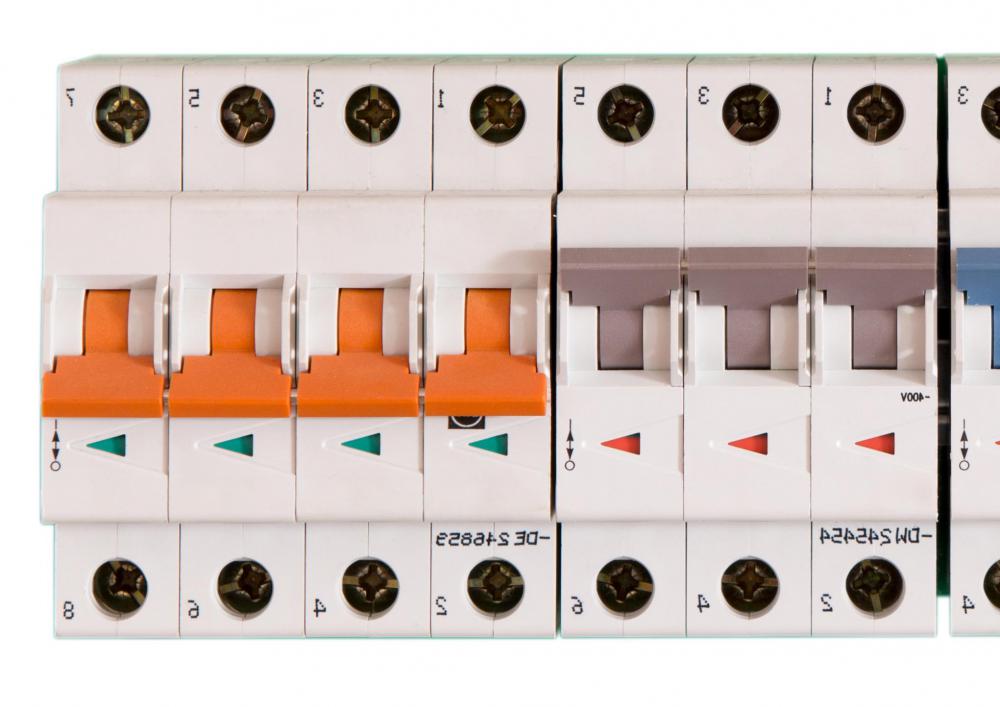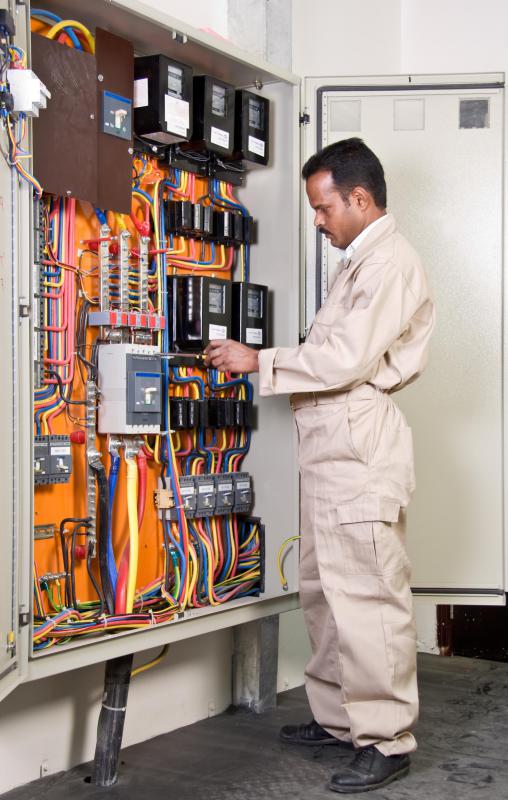At HomeQuestionsAnswered, we're committed to delivering accurate, trustworthy information. Our expert-authored content is rigorously fact-checked and sourced from credible authorities. Discover how we uphold the highest standards in providing you with reliable knowledge.
What Is an Electrical Short?
An electrical short or a short circuit is a problem which occurs when an accidental path is created in a circuit, generating a connection where one did not exist before. Since electrical current follows the path of least resistance, it would follow this path rather than the one established in the circuit, causing an unusually high flow of current. Classically, shorts occur when bare wires cross, as for example when the insulation in an old outlet wears away, allowing wires to touch each other. People sometimes use the term “short” to refer to any problem with an electrical system, regardless as to whether or not it is a true electrical short.
Electrical shorts are very serious problems. The high rate of current results in the generation of heat, which can cause sparks or a fire. An electrical short often generates a distinctive popping noise when the circuit is activated, as the electricity follows the new connection it has discovered and the circuit is suddenly overloaded with energy. Smoke or flames may appear, and the short can be strong enough to melt insulation on electrical wiring, or to cause damage to the circuit itself.

In addition to being caused by worn insulation, an electrical short can also occur when a circuit is not wired properly, as for example when someone fails to notice that the metal lining of an electrical outlet is in contact with one of the wires. Shorts can also be created by damage. Storms often cause a plethora of electrical shorts which overwhelms the grid when trees and branches fall on power lines.

Circuit designers are well aware that shorts are a common hazard, whether one is making a lamp or laying out power lines. As a result, many circuits are equipped with overcurrent protection. Overcurrent protection detects an unusually high rate of current, and trips the circuit off to reduce the risk of damage. Many people have experienced tripped breakers or blown fuses as a result of overcurrent protection on household circuits.

When an electrical short occurs, it needs to be addressed. If someone is not comfortable working with electricity, an electrician can be called in to determine the cause of the short and repair it. Unrepaired shorts can cause fires and severe damage, and it's usually cheaper to get an electrician out the minute a problem occurs, rather than to wait for a fire to spark, or for an electrical system to fail catastrophically.
How To Find an Electrical Short With a Multimeter

Encountering a short circuit is not an uncommon occurrence when you are working with electricity. However, if you do not take the time to fix the problem, this could cause circuit board damage that ultimately leads to more serious and expensive repairs. The first step in this situation is to locate the origin of the issue. To do so, it is important to learn how to find an electrical short with a multimeter.
A multimeter is an instrument that provides electrical readings. Its handheld size makes it convenient to use for household measurements on most appliances and wiring systems.
With just a few basic steps, you will be able to safely and efficiently find an electrical short with a multimeter.
Always Begin With Safety First

Anytime you are working with electricity, every safety measure must be taken before you begin. For example, when you are attempting to find an electrical short, it is critical that you first power down your circuit. Proper precautions such as this will keep you and the people around you safe from injury. They also will keep your circuits and multimeter safe from damage.
Set and Test Your Multimeter
Once you have set your multimeter to resistance mode, the next step is to calibrate it so you receive consistent and accurate readings. You can calibrate your multimeter by simply touching the probes together. If your reading is zero, or close to zero, your multimeter is calibrated and ready.
There are newer multimeters that provide users with a built-in calibration feature. This function is helpful if your initial reading is not within 0.05 Ohms. All you have to do is keep touching the lead and ground tips together and, depending on the model, simultaneously press the button or turn the knob that is designated for calibration. Your multimeter is calibrated once it displays zero.
Narrow Your Search With the Multimeter
In order to narrow your search to find an electrical short, which will save you time and make your repair more manageable, focus only on circuit components with measurable resistance. How to find an electrical short then amounts to correctly using the multimeter's red and black probes. Keep the black probe in constant contact with the circuit's electrical ground and touch the red to the component you are assessing.
Inspect the Reading
Check the multimeter's measurement in resistance mode. If it shows a "1," then you have identified the electrical short. A short may also register as "OL," which means that the circuit's loop is open and the path is broken.
How To Tell if You Have an Electrical Short in Your Car
The complex electrical systems of newer vehicles on the road are intended to provide drivers with safety, convenience and luxury. When one of the components has an electrical short, however, all of that can quickly change to danger, inconvenience and frustration.
The first step before a repair is learning how to tell if you have an electrical short in your car. There are a few common symptoms to watch for:
- You hear a clicking sound when you attempt to start the engine.
- You smell burning rubber or plastic while operating the vehicle.
- You see the check engine indicator appear every time you start the vehicle.
- You notice that your headlights, brake lights and turn signals are dim, flickering or not working at all.
- You experience power lock, power window, center display or other driving control failures.
How To Fix Electrical Short in House Ceiling Fixtures
House ceiling fixtures are just as susceptible to shorts as any other electrical system around a house. When this occurs, every component that is on that circuit is going to experience a power loss. Your first step to fix an electrical short in a house ceiling fixture is to safely locate it. Once you have done this, depending on the cause, the following steps will help you repair it:
- Closely inspect the fixture to determine if the short was the result of a connection issue. If this is the case, simply tighten the loose or sagging wires.
- Consolidate any stray wire strands that may have folded into another wire or a terminal screw. If the screw was burned in the process, it is important to replace it to avoid future conductivity issues from any resulting carbon deposits.
- If you are able to rule out the fixture as the cause for the short, it may have occurred due to wire damage from heat exposure. If this is the case, it is often best practice to call a certified electrician to identify the location of the damaged wire and then professionally make the repair.
Frequently Asked Questions
What causes an electrical short circuit?
An electrical short circuit occurs when there is a disruption in the normal electrical flow due to loose connections, damaged insulation, corrosion, physical damage to wires, or water intrusion. This diversion of electrical current can lead to a short circuit.
What are the risks of an electrical short circuit?
Electrical short circuits pose significant risks, such as electrical shocks, fires, overloading of electrical systems, and damage to appliances and electronics. They may also lead to power outages and cause severe damage to your electrical system.
How can I detect an electrical short circuit?
Signs of an electrical short circuit may include a burning smell, flickering lights, buzzing or humming sounds, or sudden power surges. If you're experiencing these things, make sure to call an electrician sooner rather than later.
How can I prevent electrical short circuits?
Make sure all electrical connections are tight and corrosion-free to avoid electrical short circuits. Regularly inspect wiring for any signs of physical damage or wear and replace damaged wiring as soon as possible. Make sure your electrical system is properly grounded and that all outlets are adequately insulated.
What should I do if I suspect an electrical short circuit?
Turn off the circuit breaker for the area in question and get an electrician to come and check out your wiring and appliances if you suspect a short circuit. It is crucial to have a professional electrician address any electrical issues, as they have the expertise to safely and correctly identify and repair any problems.
AS FEATURED ON:
AS FEATURED ON:















Discussion Comments
Overload protection does not protect against short circuits. Overcurrent protection does.
"What's the Difference?" you ask.
Overload protection protects equipment.
Overcurrent prtection protects people.
I crossed two wires together accidentally. What should I do to get the lights back on and such?
@Lonelygod: I just had this happen to me. It was arcing around the busbar of my breaker that was causing the fluctuations.
If you find the lights in your home flickering and dimming, as well as notice your power fluctuating, could an electrical short cause this?
I have noticed that our lights seem to dim quite a bit throughout the night, but occasionally go back to working at full power. It also seems to affect our modem and anything we have plugged in.
If it isn't an electrical short, what are some of the other things that could be causing this?
We would really like to get this fixed as it is bothersome and we worry there many be something potentially serious causing it.
If you ever notice an electrical short in your house do not attempt to fix it yourself unless you have some electrical experience. Playing with an electrical short is an excellent way to get electrocuted.
I lived in an older house and some of the wires started sparking. We nearly had a fire, but managed to get someone in to fix it right away. My friend at the time was all gung-ho about trying to fix it himself, although we managed to keep him off the wires.
Our electrician told us that without the proper safety equipment our friend would have been probably hospitalized for touching the live wires.
Post your comments